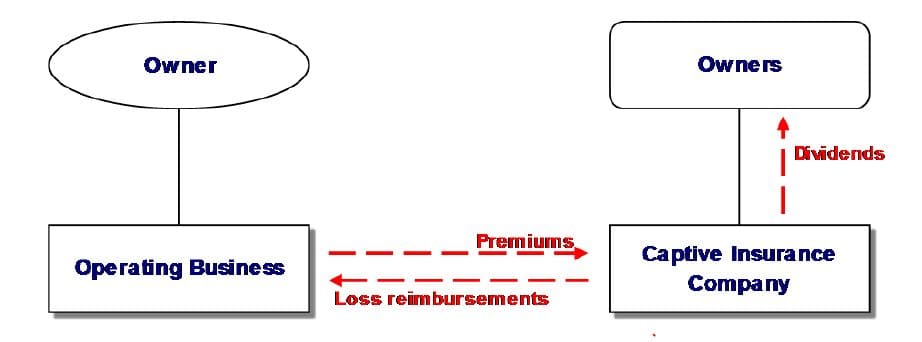For a profitable business, a captive insurance company arrangement can be an effective and flexible business risk management tool that also provides potentially significant tax and asset protection benefits. This article provides an overview of the benefits of a small casualty insurance company arrangement for a closely held business. It also discusses recent tax developments that not only increase the benefits of such arrangements, but also increase the need for proper planning and implementation.
Typical Captive Insurance Company Arrangement
In a typical captive insurance company arrangement, a business owner forms and capitalizes a state-licensed and regulated insurance company (the Captive), which then issues to the business insurance policies covering risks that are not insured under the business’s existing commercial insurance policies (such as deductibles and uninsured risks). The Captive might be owned by the owners of the operating business, by the owners and key employees, or by a trust for the benefit of the business owner’s family, or by some combination of the foregoing.
The following diagram illustrates a typical captive insurance company arrangement.

The costs to form and operate a captive insurance arrangement include:
-
the cost to capitalize the captive (which ranges between $100,000 and $500,000 for a typical structure, but can be as low as $25,000 for certain pooled insurance arrangements);
-
expenses associated with identifying business risks that are appropriate to insure through the Captive and with setting reasonable premium rates for the insurance; and
-
expenses for a third-party administrator to assist with the formation and ongoing administration of the Captive (e.g., administration of insurance policies in force, accounting for premium billings and collections and investment of capital and underwriting reserves, preparation and filing of annual reports and other regulatory filings, and other administration matters).
A captive insurance arrangement can be economically viable with annual premium volume of as little as $100,000. Premiums are generally 5 percent to 10 percent of revenues (depending on other insurance coverage, business risks, and profitability).
Premiums paid to the Captive are invested during the policy period (along with the initial capital amount) in investments authorized by the applicable regulatory scheme, which generally requires highly liquid low-risk investments. Once the policy period for a pool of premiums expires, any underwriting profits can generally be distributed as a dividend or reinvested in less restrictive investment classes.
Risk Management Benefits
A captive insurance arrangement is first and foremost a powerful risk management tool. The Captive typically writes insurance policies covering risks of the operating business that are not currently being insured under the company’s existing commercial insurance policies. Examples include loss of key vendors or major contracts, cybersecurity breaches, expenses to repair news media reputational damage, adverse financial consequences of legislative and regulatory changes, and loss of franchise license or lease. Policies covering these risks are often not available in the commercial insurance market or may prove too costly to obtain. Many of the risks that should be considered for a captive can be found in the exclusions sections of the company’s existing policies, and an uncovered loss is often the impetus for a business establishing a captive.
By obtaining coverage for these risks through the Captive, the company can more effectively identify its uninsured risks, institute loss prevention and containment measures for the risks as appropriate, and set aside assets to cover future losses and smooth the cash flow effects of a loss.
A Captive has many advantages over insuring the risks in the traditional insurance market, including streamlining claims review and processing, insulating the company from wild swings in premium rates that can occur in the commercial insurance markets, avoiding or minimizing profit loads, broker commissions, and administrative costs associated with traditional insurance, and capturing for the company savings associated with investment of policy reserves and better than average claims experience. Analysis of these advantages can sometimes cause a company to reconsider whether some risks being insured through the traditional insurance market should instead be insured through a captive arrangement.
Tax Benefits
In addition to providing impressive risk management benefits, a small captive insurance company enjoys a significant income tax benefit. And, in the context of a closely held business, a captive insurance arrangement can also provide significant gift and estate tax benefits under certain conditions.
Income Tax Benefits
Effective January 1, 2017, assuming the Captive receives less than $2.2 million of net written premiums for the tax year and satisfies certain diversification requirements discussed below, it is subject to tax only on its taxable investment income; its underwriting income is exempt from tax. This means that while the business obtains a deduction against ordinary income for the premiums paid to the Captive, the Captive is not subject to tax on the premium income. Business profits are effectively converted into nontaxable income (to the extent the Captive’s premium income exceeds its losses and operating expenses). When the Captive’s underwriting income is distributed to a family trust, the Captive’s owners are taxed on the income at qualified dividend rates (currently taxed at a maximum rate of 23.4 percent).
If a business generates significantly more than $2.2 million in profits and premiums annually, it may be possible to use more than one small captive insurance company arrangement to maximize the income tax benefits of the arrangement.
Gift and Estate Tax Benefits
In addition to the income tax benefits described above, a small captive insurance company arrangement can also provide significant gift and estate tax benefits, provided the Captive is structured to satisfy the policyholder diversification requirement described below. If the policyholder diversification requirement is satisfied, underwriting profits of the Captive – which would, in the absence of the captive arrangement, accrue to the business owner and be included in his or her taxable estate at death – can potentially accrue to lower generation family members without incidence of gift or estate taxes and without using any of the business owner’s annual or lifetime exclusion amounts. If the ownership of the Captive is held in a properly structured family trust, the arrangement may be able to avoid generation-skipping transfer taxes, and, by having the family trust taxed as an intentionally defective grantor trust for income tax purposes, may facilitate the business owner effectively transferring additional assets to the trust free from gift taxes by having the business owner pay the income taxes due on income of the trust (i.e., dividends received from the Captive).
Diversification Requirements (New)
In late 2015, Congress amended the Internal Revenue Code so that effective January 1, 2017, an insurance company does not qualify as a small captive insurance company eligible for exemption from tax on underwriting income unless it meets one of two diversification requirements.
Policyholder diversification requirement: As noted, the gift and estate tax benefits described above are available only if the Captive satisfies a “policyholder diversification requirement.” An insurance company satisfies the policyholder diversification requirement if no more than 20% of the insurance company's premiums come from any one policyholder (insured). Captive insurance companies should be able to satisfy this test by participating in reinsurance pools comprised of unrelated policyholders. At least 80 percent of the premiums paid by the operating company are paid into the reinsurance pool. Obviously, great care must be taken in structuring the reinsurance pool to minimize the risk that claims of unrelated policyholders will exceed the premiums they have paid into the pool.
Shareholder diversification requirement: If the policyholder diversification requirement is not satisfied, the Captive generally must satisfy a “shareholder diversification requirement,” generally meaning that the Captive must be owned by the same shareholders, and in substantially the same percentages, as the owners of the operating business. This requirement obviously precludes any gift and estate tax planning. Moreover, even if the shareholder diversification requirement is satisfied, the Captive still must meet a 50 percent policyholder diversification test under general tax principles related to the fundamental nature of insurance. Therefore, as a practical matter, many business owners may prefer to structure their captive insurance arrangements to satisfy the policyholder diversification requirement, and pursue the gift and estate tax planning opportunities afforded by that structure.
Asset Protection Planning
In a properly structured captive insurance arrangement, the premium dollars moved to the Captive, and the earnings on those premium dollars, are removed from the reach of creditors of the business and the owners, except to the extent the premiums and earnings are used to cover losses insured by the Captive. For the owners of a business operating in a high risk industry (like health care, chemicals, transportation, etc.), or for any business owner concerned about potential future creditor claims, the asset protection planning afforded by a captive can be a significant benefit.
Enhanced Reporting Requirements (New)
In November 2016, the IRS issued Notice 2016-66 designating certain small captive insurance arrangements (generally including arrangements of the type contemplated by this paper) as a “transaction of interest” for purposes of certain enhanced tax reporting requirements under the Internal Revenue Code. Under those tax reporting requirements, each of the persons participating in a covered captive insurance arrangement during a taxable year will be required to report information regarding the arrangement on IRS Form 8886 (Reportable Transaction Disclosure Statement) with the person’s tax return for each such year. In addition, certain advisors to the arrangement will be required to file a disclosure statement regarding the transaction and maintain lists of persons participating in the transactions.
The IRS notice acknowledges that small captive insurance companies may be used for risk management purposes that do not involve tax avoidance, but also notes that there are abusive cases in which such arrangements are not properly characterized as insurance for tax purposes. For example, the policies may cover implausible risks for exorbitant premiums, may duplicate existing coverages, or may otherwise lack sound actuarial assumptions and substantiation. The IRS notice underscores the importance of proper design and implementation of a captive insurance arrangement.
Conclusion
A captive insurance arrangement can be a powerful risk management tool that provides significant income tax, estate and gift planning, and asset protection benefits to a successful privately held business. For more information, please contact James Browne at jim.browne@btlaw.com or the Barnes & Thornburg attorney with which you work.
© 2017 Barnes & Thornburg LLP. All Rights Reserved. This page, and all information on it, is proprietary and the property of Barnes & Thornburg LLP. It may not be reproduced, in any form, without the express written consent of Barnes & Thornburg.
This Barnes & Thornburg LLP publication should not be construed as legal advice or legal opinion on any specific facts or circumstances. The contents are intended for general informational purposes only, and you are urged to consult your own lawyer on any specific legal questions you may have concerning your situation.













